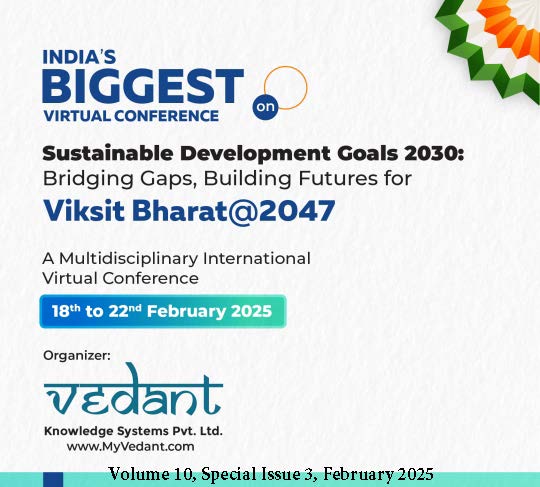A Qualitative Analysis of the Interlinkage Between Gender and Climate
DOI:
https://doi.org/10.58213/vidhyayana.v10isi3.2242Keywords:
Gender disparities, climate change, environmental degradation, gender-sensitive policies, sustainability, climate adaptation, women’s empowerment, socio-economic inequalities, gender wage gapAbstract
This study explores the complex interlinkages between gender disparities and environmental challenges, highlighting how systemic inequalities exacerbate women’s vulnerabilities to climate change, natural disasters, and resource degradation. Using a qualitative approach, the research examines how environmental degradation disproportionately affects women due to entrenched socio-economic barriers, limited resource access, and exclusion from decision-making processes. Drawing insights from diverse contexts, including rural Zimbabwe, Bolivia, Nepal, Australia and South Africa, it underscores the urgent need for gender-sensitive policies in climate adaptation and resilience building. The findings reveal that integrating women’s perspectives and leadership into environmental and economic frameworks enhances sustainability outcomes, emphasizing the interconnectedness of gender equality, climate action, and sustainable development.
Downloads
References
Agarwal, B. (1992). Feminist environmentalism. Economic and Political Weekly, 27(43), 37-47.
Belasen, A. R., & Polachek, S. W. (2009). Wage and employment shifts after hurricanes. Southern Economic Journal, 76(1), 134-152.
Brown, C., & Ridge, S. (2002). Gender wage differentials in the Australian public sector under deregulated systems. Journal of Labor Economics, 20(2), 55-72.
Buckingham-Hatfield, S. (2000). Gender inequalities and environmental vulnerabilities. Journal of Environmental Planning and Management, 43(4), 481-495.
Chanaka, E. (2014). Climate change and rural women in Zimbabwe. African Journal of Environmental Studies, 12(3), 215-230.
Daoud, H. (2021). Gendered climate vulnerability in Egypt. Middle East Journal of Climate Change, 5(4), 241-259.
Duerto-Valero, A., et al. (2024). The gender-environment nexus: Data-driven frameworks for policy. Global Environmental Politics, 30(1), 45-63.
Escalante, A., & Maisonnave, H. (2022). Environmental degradation and gender inequalities in Bolivia. Development and Change, 53(5), 973-991.
Kabir, H. (2018). Gaps in global climate frameworks: A gender critique. International Journal of Climate Policy, 14(3), 321-334.
Kirschberger, M. (2017). Labor market disruptions caused by natural disasters. World Development, 95, 80-93.
Mueller, V., & Quisumbing, A. (2011). Labor disruptions caused by the 1998 Bangladesh flood. Food Policy, 36(5), 611-620.
Nightingale, A. (2006). The nature of gender: Work, gender, and environment. Environment and Planning D: Society and Space, 24(2), 165-185.
Nyutu, E. N., Cobern, W. W., & Pleasants, B. A. S. (Year). Correlational study of student perceptions of their undergraduate laboratory environment with respect to gender and major. Journal of Science Education Research, 12(1), 50-68.
Okere, J., et al. (2023). Ecological stressors and female economic participation in Africa. Journal of Development Economics, 35(4), 122-139.
Osberghaus, D. (2016). Labor market impacts of natural disasters: Recovery and gendered outcomes. Disasters, 40(3), 440-464.
Pinho-Gomes, A. C., & Woodward, M. (2025). Gender equality and climate adaptation: Global insights. Nature Climate Change, 15(2), 178-189.
Pleasants, B. A. S., Nyutu, E. N., & Cobern, W. W. (Year). Correlational study of student perceptions of their undergraduate laboratory environment with respect to gender and major. Journal of Science Education Research, 12(1), 50-68.
Rodríguez-Oreggia, E. (2013). Labor market impacts of hurricanes in Mexico. Journal of Regional Science, 53(3), 547-570.
Shayegh, A., & Dasgupta, A. (2025). Labor and wage implications of climate change for women in South Africa. South African Journal of Economics, 45(1), 89-105.
Swai, I., & Magayane, F. (2012). Gender-specific adaptation practices in Tanzania. African Journal of Agricultural Research, 7(29), 4161-4171.
Zhong, X., & Huang, T. (2019). Compounded health and economic risks of climate change for women. Climate Policy, 19(7), 882-899.
Food and Agriculture Organization (FAO). (2023). Women in agriculture: Closing the gender gap for development. Retrieved from https://www.fao.org
International Labour Organization (ILO). (2023). Global Wage Report 2023: The gender pay gap. Retrieved from https://www.ilo.org
United Nations Development Programme (UNDP). (2023). Gender equality in climate negotiations: Progress and gaps. Retrieved from https://www.undp.org
United Nations Women (UN Women). (2023). Sustainable Development Goals and gender equality. Retrieved from https://www.unwomen.org
